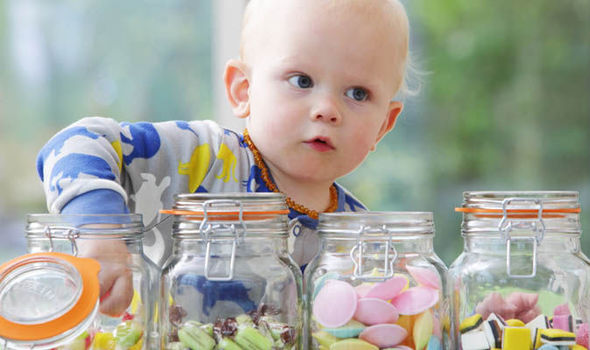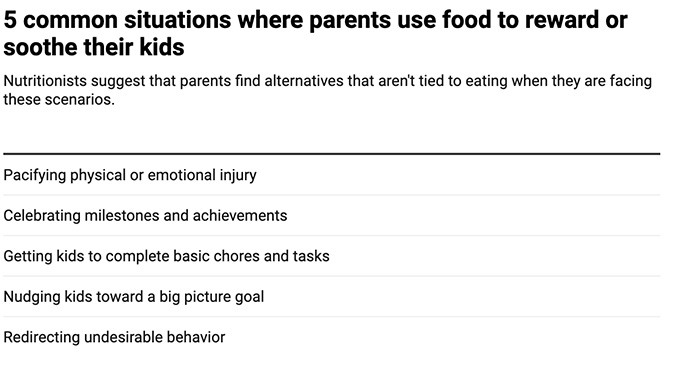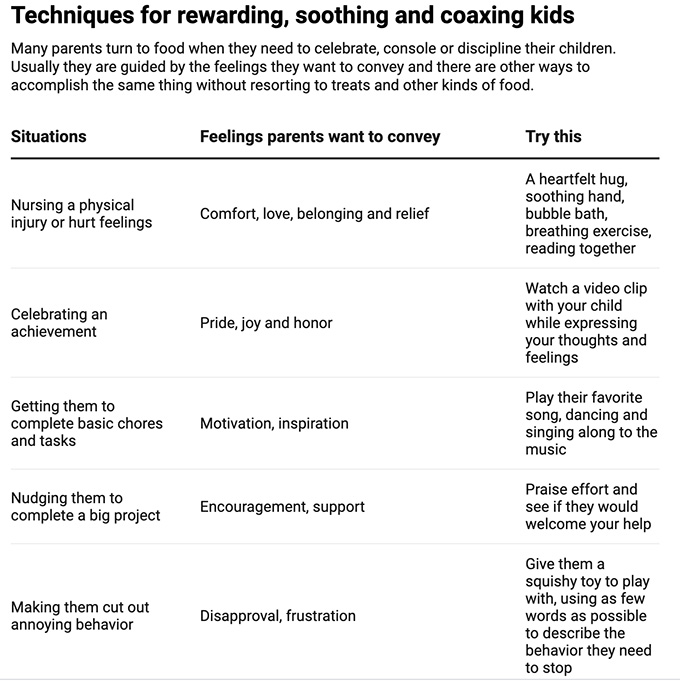
At one time or another, just about every parent uses food to reward their kids for good behavior and achievements – or to console them when they’re sad or disappointed.
When children make honor roll, win a big game or persevere through a struggle, a parent might express their pride and joy with candy or ice cream. Likewise, when kids feel down and out, pick-me-ups can take the form of a treat. The reasons for this are simple: Using food as an incentive might get results, and salty, sweet or sugary foods are often within easy reach.
You may figure there’s no harm in doing this kind of thing. But as a dietitian and nutritionist focused on family nutrition, I consider regularly using food as an incentive for kids to be risky.
Rewarding and comforting kids with food can lead to overeating when they are not hungry. It also increases the chances they will try to deal with their emotions through what they eat.
I spend a lot of my time at work helping clients break this cycle. I show them how to stop using tactics like bribery, judgment and shame that involve foods and drinks that can range from a bowl of chocolate pudding to a big glass of soda. I also teach parents other ways to celebrate and soothe that don’t depend on food.
Plenty of research shows kids consume more total calories, carbohydrates and fat daily when parents use food to reward behavior. For example, when the mothers of preschool-age children use food to ease their kids’ emotions, those children eat more sweets when they get upset. And a French study found that moms who used food as rewards for their children stimulated their kids’ tendency to overeat – even when their children aren’t hungry. Of course, it’s not just moms and dads using food in this way but caregivers of all kinds, from babysitters to grandparents. And while it’s a big problem at school too, changing patterns at home is key.
To help parents get the hang of kicking this habit, I’ve zeroed in on four steps to purge guilt and let go of food as a reward.
1. Recognize common scenarios
Think about how you celebrate after performances or if you often promise a treat when your kids finish a task. Do you prod your kids to clean their room by dangling the possibility of dessert? Do you take them out for pizza to help them cope when they don’t make the team? Recognizing common scenarios is an essential first step toward breaking this pattern.

2. Don’t blame yourself
You are not alone if food is ingrained in how you interact with kids when you’re not at the table. What matters most is your willingness to explore a new path without stewing in self-judgment. Using food to reward kids undermines healthy habits you’re trying to instill, so any effort toward change may have long-term benefits.
3. Name the feeling you aim to convey
Separating your intent from your actions will help you stop using food as a way to soothe or praise. To do this, imagine your child in a situation where you might use food that way. Play the scene out in your mind, stopping before you bring on the food. As you envision your child in the scenario, ask yourself what feeling you would like to convey.
For example, your kid falls down on the sidewalk and skins their knee. You crouch to comfort them and tend their wound as the wailing escalates. You keep consoling after you’ve carefully stuck a Band-Aid on them but they just can’t calm down. If you’re like many of my clients, you’ll be tempted to say, “I’ll help you up and then we can go get ice cream.”
Ask yourself at that point what feeling you want them to perceive. In this case I’ll wager that it’s comfort and relief – rather than a delicious dairy product.
Becoming mindful of your specific feelings enables two things to happen. First, you’ll see how food stands in for various emotions. Second, it will help you separate your feelings from food – making it easier to deliver something else that’s truly needed in the moment.
You can also try saying your feelings out loud. For example, when your child doesn’t get invited to a friend’s party, say, “This feels sad. My wish for you is knowing how much you are loved.” That can help you remember to try something else besides food to console them.
4. Do something else
There are plenty of ways to comfort your kid that don’t involve food. You can hug them or give them a bubble bath, for example.
To celebrate, try watching a family video together, taking the time to say what makes you feel most proud of them. If you’re trying to motivate or inspire your child, you can crank up their favorite song, then dance and sing along with the music.
When you want to compel or encourage kids to, say, do their homework, give praising their effort a try. Tell them that you see them working hard and ask: “How can I support you right now?”
With small children, when they’re refusing to leave the playground or get into a bath, try engaging them with a stuffed animal or squishy toy to fidget with.
Try to get your child to help choose some alternatives. They might have good ideas that don’t occur to you.

Ways and words
Using food to reward or console kids is pervasive enough that the American Academy of Pediatrics and five other professional organizations recommend that parents not use food this way.
But no one, including doctors, is suggesting that you should never make a birthday cake or use food as a reward in any situation. Food is an integral part of cultures everywhere and meant to be fully enjoyed.
Should you find that you regularly rely on food to express emotions with your kids, I believe you ought to try to switch gears.
It’s all about finding ways and words, instead of using food, to show your kids how much you love them.